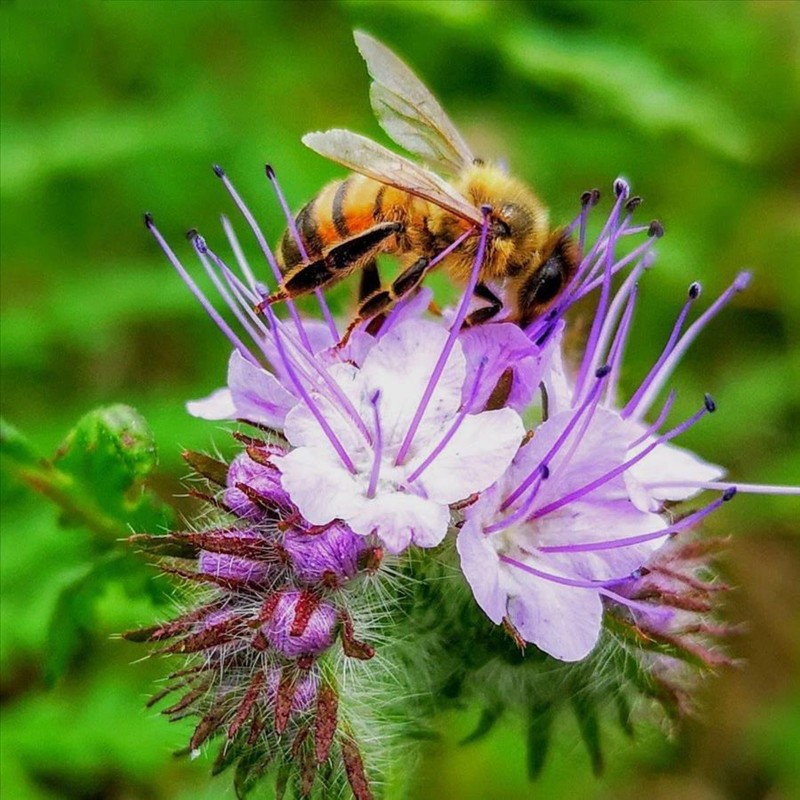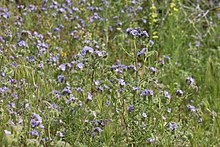





Facelia is an annual plant whose flowers give high yields of nectar. It is calculated that it can collect 500 - 1,000 kg / ha of honey, which depends on sowing, weather conditions, and the length of the day.
Facelia is an annual plant whose flowers give high yields of nectar. It is calculated that it can collect 500 - 1,000 kg / ha of honey, which depends on sowing, weather conditions, and the length of the day. It originates from America and was introduced to Europe at the beginning of the 19th century.
It is similar to weeds, growing about 60-90 cm. Branches begin already in the lower part of the stem. On each branch we find twigs that bear tiny flowers. The petals are purple in the upper part, and turn white at the bottom. One plant contains from 5,000 to 7,000 flowers. In place of the flowers, a cocoon-shaped fruit is created that contains seeds. We will find one to two seeds on the smaller branches, and three to four seeds on the larger ones. The pods at the top, as a rule, contain fewer seeds than those at the bottom. The immature seed is white, which turns orange, and in the end the mature seed is dark brown to black.
Facelia is a leguminous plant, which means that bacteria develop on its root, which are able to bind elemental nitrogen from the air. The root penetrates to a depth of 70 cm and is relatively dense. In that way, it improves the structure of the soil, and by dying, it leaves significant amounts of organic matter and bound nitrogen, which makes this plant suitable for improving bad soils. In addition, the whole plant can be plowed at the end of flowering, which is why it is also suitable for green manure of vineyards or orchards.


Phacelia tanacetifolia is an annual that grows erect to a maximum height near 100 centimeters (39.37 inches) with none to a few branches. The wild form is glandular and coated in short stiff hairs. The leaves, 20–200 millimetres (0.8–7.9 in), are mostly divided into smaller leaflets which are deeply and intricately cut into toothed lobes, giving them a lacy appearance. The dense and hairy inflorescence is a one-sided curving or coiling cyme of bell-shaped flowers in shades of blue and lavender. Each flower is just under a centimeter long and has protruding whiskery stamens.[2]
The seeds are "negatively photoblastic", or photodormant, and will only germinate in darkness.[3]
Phacelia tanacetifolia is native to Southwestern United States and northwestern Mexico. It is most common in the deserts of southern California below 5,000 feet (1,500 m), but may be occasionally found at much higher elevations. [4][5]
It is used outside its native range in agriculture as a cover crop, a bee plant, an attractant for other beneficial insects, as a green manure [6] and an ornamental plant. It is planted in vineyards and alongside crop fields, where it is valued for its long, coiling inflorescences of nectar-rich flowers which open in sequence, giving a long flowering period.[7] It is a good insectary plant, attracting pollinators such as honey bees.[7]
It is also attractive to hoverflies (family Syrphidae), which are useful as biological pest control agents because they eat aphids and other pests.
We can sow facelia at any time of the year if the weather is favorable and the soil is properly prepared for sowing. However, we usually sow it from February to May, and if the weather is wet, in June as well. It is best to sow during March because at that time there is enough moisture in the soil and the intensive growth of weeds is not starting yet, so the phacelia later chokes them. In addition, no additional hoeing or use of herbicides is required, which is not desirable in honey production. The bees will be able to use what was sown at the right time for grazing.
It can be successfully grown as the mainspring crop, but also in lateral sowing. However, in California, it is mainly grown as a winter crop because it tolerates frosts and low temperatures up to -8 ° C relatively well.
It is sown to a depth of 1.5 to 2 cm, wide or in rows at intervals of up to 20 cm. One of the specific properties of facelia is that the germination of seeds is inhibited by sunlight, which is why it must not remain on the surface.
5 - 10 kg / ha of seeds are usually used for sowing, depending on the sowing date and the quality of pre-sowing soil preparation. When growing facelia for green manure (sideration), slightly larger quantities of seeds are sown.

 Reviews (0)
Reviews (0)